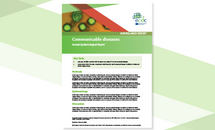Lymphogranuloma venereum - Annual Epidemiological Report for 2019
Lymphogranuloma venereum (LGV) is a systemic sexually-transmitted infection (STI) caused by Chlamydia trachomatis serovars L1, L2, or L3. In 2019, 3 112 cases of LGV were reported in 23 countries in the European Union/European Economic Area (EU/EEA). Four countries (France, the Netherlands, Spain, and the United Kingdom) accounted for 87% of all notified cases. Almost all cases in 2019 were reported among men who have sex with men; among the cases with known HIV status, 64% were HIV-positive. The number of reported cases in 2019 is the highest since 2004 and represents a 30% increase compared with 2018 and 75% increase compared with 2015.
Download






